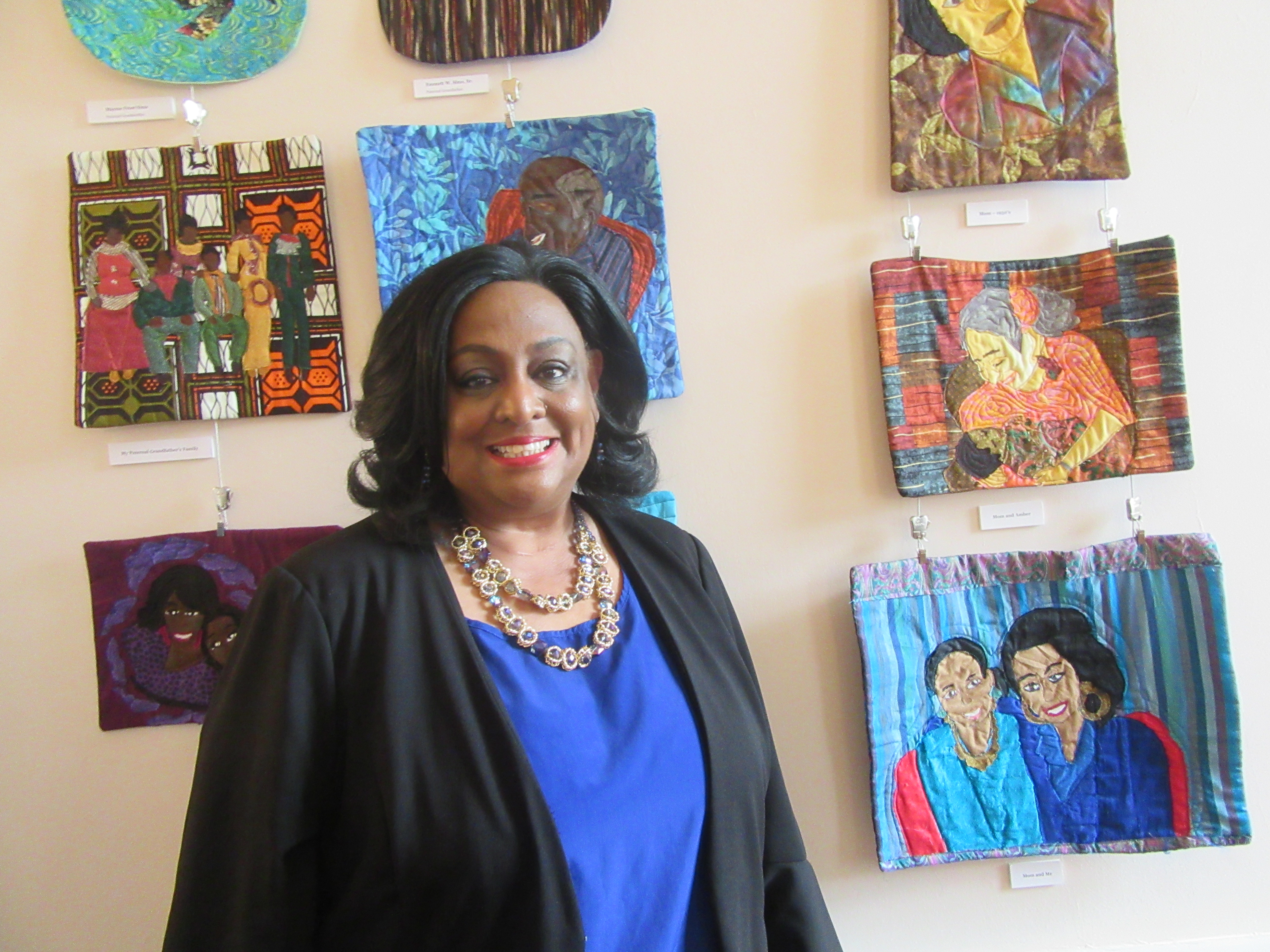Sunday, October 15, 2023
After Sheryl Sims got bored with traditional quilting, she started making story quilts and found her calling. “I paint with fabric. I quilt what is in my heart and mind,” she explained at an Oct. 2 opening reception attracting 94 admirers.
Until Dec. 31, Woodlawn and Pope-Leighey House are displaying 63 of her story quilts in a free exhibit titled “Story Quilts, Inspired by Family and Faith.” Quilt sizes vary, with many around 20 by 30 inches and each recounts her family history, her faith or an African-American historical event.
She does machine quilting with raw edge appliqué. She often uses colorful fabrics and eschews patterns. Sims enjoys the creativity, what she calls “the no-rules approach.” She can make a story quilt in one day.

Sheryl Sims, quilt artist.
Stitching her family history evolved from her efforts to join the Daughters of the American Revolution (DAR), an organization that requires one “to prove lineal, bloodline descent from an ancestor who aided in achieving American independence,” says the DAR website. The daughter of a military officer, Sims had lived all over the world and knew little about her ancestors beyond her great-grandparents. In six years of research, she traced ten generations, complicated by scant records for the enslaved people in her background. She found an ancestor who contributed money to the cause, a White, sixth great-grandfather. “I did not find a patriot of color,” she says. She joined the DAR in 2022.
Presentation on Quilts
On Nov. 4 at 4 p.m., Sheryl Sims will make a presentation about her quilts. Visit http://www.woodlawnpopeleighey.org/upcomingevents.
Her Stories
Several quilts portray members of her family, including her parents. One depicts her second great-grandmother, Chancy Tillman, an enslaved Louisiana woman who was freed and lived to age 100. Another portrays the Hollingsworth family reunion. Valentine Hollingsworth, her maternal great-grandfather, came to America from Ireland with William Penn.
Especially poignant are the African-American history quilts, like a scene depicting the 1968 assassination of Reverend Martin Luther King at Memphis, Tennessee’s Lorraine Motel. Another shows Rosa Parks on a Montgomery, Alabama bus, titled “Rosa Parks Takes a Seat.” In 1955, Parks refused to give up her seat to a White man as the law required..
One quilt portrays the 1954 U.S. Supreme Court decision, Brown v. Board of Education, which found that public school racial segregation was unconstitutional.
Another relates the horrors of Goree Island, Senegal’s “Door of No Return.” According to the African American Registry, “Goree Island was a slave-holding warehouse, an absolute center for the trade of African men, women and children. Millions of West Africans were taken against their will. Many of these Africans were brought to Goree Island, sold into slavery and held in the holding warehouse on the island until they were shipped across the Atlantic Ocean.”
“Hope” greets arriving exhibit visitors, created after former U.S. Supreme Court Justice Ruth Bader Ginsburg died in 2020. It recalls the day Sims joined a diverse crowd at the U.S. Supreme Court building and reflects Ginsburg’s spirit. “She wouldn’t want everyone out here crying. She would want us to maintain hope,” Sims believes.
Two quilts highlight local landmarks, the Woodlawn Quaker Meeting House and Alexandria’s Christ Church.
“Here at Woodlawn, we are in the midst of a transition as we endeavor to better tell the full history,” said Shawn Halifax, Woodlawn’s Executive Director. “We are engaging with our community to preserve history at this former site of enslavement, and I cannot think of a more appropriate way to do this than collaborating with Sheryl on this exhibit.”
Sims lives in the Manchester Lakes area of Fairfax County and is legal secretary in a Washington, D. C., firm.